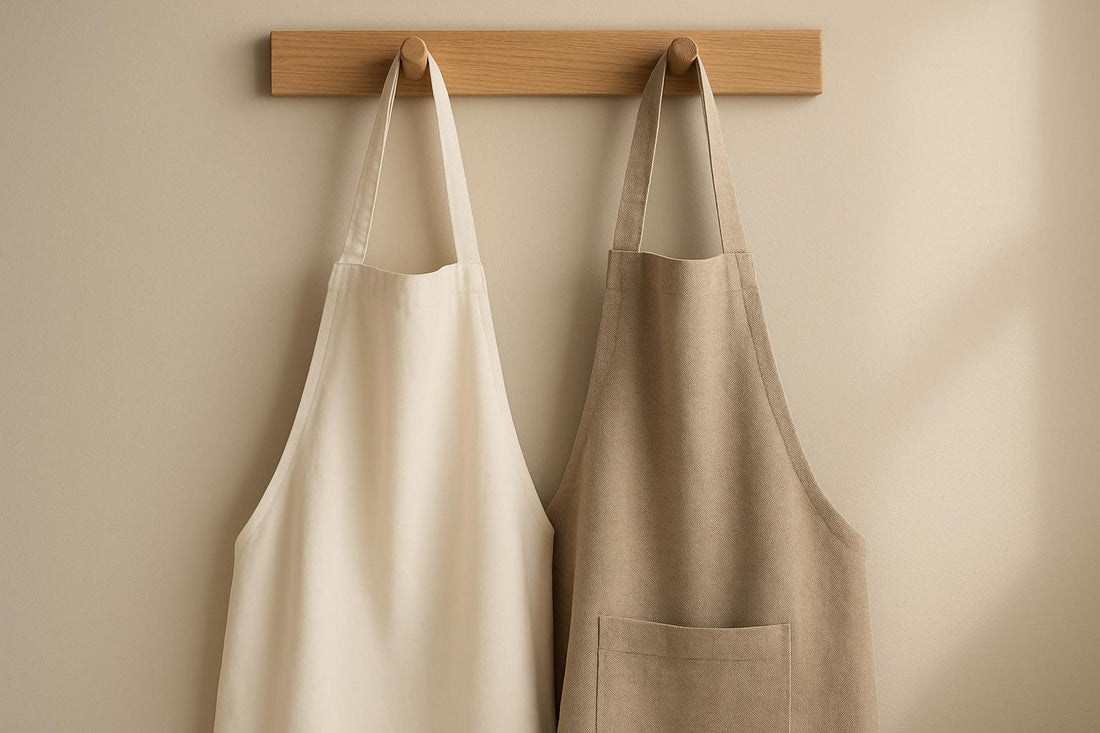
Blended Fabrics vs. Pure Cotton: Which Lasts Longer?
Share
When choosing an apron, the fabric's durability and care requirements are key. Pure cotton excels in comfort and breathability, making it ideal for long hours in the kitchen. However, it is prone to wear, shrinkage, and fading over time, especially with frequent washing. On the other hand, blended fabrics - a mix of cotton and synthetic fibers - offer superior durability, stain resistance, and wrinkle resistance, making them better for heavy use and easier to maintain.
Quick Comparison
| Feature | Pure Cotton | Blended Fabrics |
|---|---|---|
| Durability | Moderate – wears faster | High – handles frequent use well |
| Stain Resistance | Absorbs stains easily | Resists stains better |
| Wrinkle Resistance | Wrinkles easily, needs ironing | Resists wrinkles, maintains shape |
| Shrinkage Risk | High, especially in hot water | Low |
| Care Requirements | Gentle handling needed | Easier to maintain |
If you prioritize comfort and natural feel, go for cotton. For heavy-duty use and low maintenance, blended fabrics are a better choice.
Pure Cotton Aprons: Benefits, Drawbacks, and Care
Natural Comfort and Breathability
Pure cotton aprons are a favorite in the kitchen for their undeniable comfort. The natural fibers provide a soft, lightweight feel that synthetic materials just can't replicate. What makes cotton stand out is its breathability - it allows heat to escape, keeping you cooler during those long hours near a hot stove. As Hanee Aprons puts it:
"Cotton has earned its place as a beloved fabric for aprons, offering reliable performance." - Hanee Aprons
This breathability is especially helpful during intense cooking sessions. Unlike synthetic fabrics, which can trap heat and moisture, cotton wicks away sweat and absorbs up to 27% of its weight in water without feeling damp. It's also gentle on sensitive skin and offers a bit of natural flame resistance, which is a plus when working around open flames or hot surfaces. But how does cotton hold up over time? Let’s take a closer look.
How Pure Cotton Wears Over Time
While pure cotton aprons are undoubtedly comfortable, their lifespan can be affected by regular use and washing. Over time, cotton's natural fibers may shrink, fade, or lose shape, especially if exposed to hot water or high dryer heat. Colors can also gradually fade with repeated washing and sunlight exposure.
Stress points like pocket edges and ties are particularly prone to wear and tear. However, cotton does handle abrasions well, and thicker cotton aprons are often more durable. Many heavier aprons also come with reinforced stitching or metal grommets, which can help them endure daily kitchen tasks. Plus, thicker cotton fabrics provide better protection against spills and minor burns, giving them an edge over thinner alternatives.
How to Care for Cotton Aprons
Proper care can significantly extend the life of your cotton apron. Here are some simple tips to keep it looking and performing its best:
- Wash in cool or warm water to minimize shrinkage.
- Use a mild detergent to preserve softness and prevent fiber damage.
- Pre-treat stains before washing to prevent them from setting.
- Turn the apron inside out and secure ties or buckles to avoid tangling or stretching during the wash.
For new aprons, wash them separately at first to avoid potential dye bleeding. Once the colors are stable, you can wash them with similar shades. When it comes to drying, air drying is ideal to maintain the apron’s shape, but a low-heat dryer cycle works too. Harsh bleaches should be avoided as they can weaken the fibers and cause yellowing. For storage, hanging is best to prevent creases, though rolling it up is a space-saving alternative. If wrinkles appear, a medium-heat steam iron on slightly damp fabric will smooth them out quickly.
"Cotton aprons offer reliable performance with straightforward care requirements, making them excellent for regular use in various settings. Their consistent comfort and durability make them a practical choice for both casual and frequent users." - Hanee Aprons
Thanks to their quick-drying nature, cotton aprons are always ready to go, making them a dependable choice for busy kitchens where having a clean, functional apron is essential.
Cotton vs Poly vs 50/50 vs Tri-blends: The T-Shirt Test Part 1
Blended Fabrics: Durability and Performance
Blended fabrics combine natural cotton with synthetic fibers to create aprons that are tougher and longer-lasting than those made from pure cotton. Typically, these blends consist of 50% to 95% cotton, with synthetic fibers making up the rest. This mix offers a practical choice for anyone looking for aprons that can handle daily wear and tear.
Better Durability and Resistance
Blended fabrics address some of the weaknesses of pure cotton. They are more resistant to tearing and abrasion, thanks to the added strength provided by synthetic fibers. This makes them ideal for frequent use in demanding environments.
Unlike pure cotton, which can wrinkle and shrink after repeated washes, blends hold their shape and resist wrinkles far better. This means less time spent ironing and a better chance of maintaining the apron’s original fit, even after months of washing.
Easier Care and Maintenance
Blended fabrics don’t just last longer - they’re also easier to take care of. Their synthetic components make them less prone to absorbing spills, which means stains are easier to manage. This feature is especially handy in busy kitchens where accidents are inevitable.
These fabrics are also more forgiving when it comes to washing. While pure cotton often requires careful handling and precise temperature control, blends can endure a wider range of wash conditions. That said, it’s still important to follow care label instructions. For best results, wash blended aprons in cool or lukewarm water with a mild detergent to prevent shrinkage or fading. Skip fabric softeners and bleach, and dry on low heat or air-dry to avoid heat-related damage.
Comfort and Function
Blended fabrics may be tougher, but they don’t sacrifice comfort. Cotton-polyester blends, for instance, offer the softness of cotton paired with the durability of synthetics. While they may not breathe as well as 100% cotton, the added ease of care and durability often make the trade-off worthwhile.
For something with better breathability, cotton-linen blends are a solid choice. These blends provide moderate absorbency, good durability, and improved airflow compared to cotton-polyester options. Whether you’re working over a hot stove or dealing with messy tasks, blended aprons perform reliably, offering protection and comfort in a variety of kitchen conditions. Their combination of durability and functionality makes them a strong contender against pure cotton aprons.
sbb-itb-c693c43
Durability Comparison: Blended Fabrics vs. Pure Cotton
Let’s dive into how pure cotton and blended fabrics measure up when facing everyday challenges.
Comparison Table: Pure Cotton vs. Blended Fabrics
Here’s a quick look at how these two fabric types perform across key durability factors:
| Property | Pure Cotton | Blended Fabrics |
|---|---|---|
| Overall Durability | Moderate – prone to wear over time | High – withstands daily stress effectively |
| Wrinkle Resistance | Poor – wrinkles easily and needs frequent ironing | Excellent – holds shape well after washing |
| Stain Resistance | Low – absorbs stains quickly | Higher – repels liquids better |
| Shrinkage | High risk, especially in hot water | Low risk – maintains size more reliably |
| Color Retention | Good at first, but fades with repeated washes | Superior – keeps colors vibrant longer |
| Pilling Resistance | Prone to fuzzing and loose fibers | More resistant to pilling |
| Care Requirements | Needs gentle handling | Easier to wash and maintain |
This comparison sets the stage for understanding how these properties play out in real-world use.
Which Fabric Endures Wear More Effectively
When it comes to durability, blended fabrics take the lead. Cotton-polyester blends are engineered for strength, making them less likely to show wear in areas like ties and pocket edges, even after frequent use. On the other hand, pure cotton, while soft and breathable, tends to wear down faster in high-stress areas.
Stain resistance is another area where blends shine. Pure cotton’s natural absorbency makes it more prone to staining. In contrast, the synthetic fibers in blends, like polyester, repel liquids better, giving you more time to clean up spills before they leave a mark.
Wrinkle resistance is a major advantage for blended fabrics. While pure cotton is notorious for wrinkling and often demands ironing, blends maintain their shape and look polished after washing. This makes them a practical choice for those who value a neat appearance with minimal upkeep.
For demanding environments, such as busy kitchens, the benefits of blended fabrics become even clearer. They not only resist wear and tear but also hold their color and appearance far better over time. This makes them ideal for both professional chefs and home cooks who need reliable performance.
That said, pure cotton does have its strengths. Heavier cotton fabrics, like canvas or denim, are tightly woven and offer excellent durability against stains and washing. However, they require more care, which can be a trade-off for those who prefer the natural feel of cotton over synthetic blends.
How to Choose the Right Fabric for Your Apron
Selecting the right fabric for your apron depends on what you need it for. The durability of pure cotton versus blended fabrics makes each suited to different cooking styles and priorities.
Matching Fabric to Your Needs
Think about how you’ll use your apron. If comfort is your top priority, pure cotton is a fantastic choice. It’s breathable, making it ideal for long hours in the kitchen or when working near open flames. Plus, it’s gentle on sensitive skin, which is a bonus for many home cooks.
For those in professional kitchens or tackling heavy-duty cooking, blended fabrics might be a better fit. Cotton-polyester blends are tougher when it comes to frequent washing and are better at resisting stains compared to pure cotton. They’re also more budget-friendly and last longer under heavy use. If you’re worried about spills and stains, blends give you extra time to clean up before the mess sets in.
Appearance matters, too. Pure cotton offers vibrant colors and a luxurious texture, making it a great option for formal or business settings. On the other hand, blends lean toward a more casual, sporty vibe, perfect for everyday cooking or outdoor grilling.
Different cooking tasks also call for specific fabrics. Canvas or denim is ideal for heavy-duty jobs like BBQ or outdoor cooking, while lighter cotton or blended options are better for daily meal prep. If you’re working with open flames, consider flame-resistant fabrics for added safety.
Once you’ve pinpointed your needs, you can narrow down your fabric options.
Browse Apron Options at Cosmic Aprons

Cosmic Aprons has you covered with a range of pure cotton and blended fabric aprons to fit your needs. Their everyday cotton aprons are a favorite among home cooks for their natural comfort and breathability, making them a great choice for daily kitchen use.
For more rugged tasks, like outdoor grilling, Cosmic Aprons offers BBQ aprons designed for durability. These aprons feature adjustable straps to fit various body types and cooking positions, ensuring comfort during long cooking sessions while maximizing the fabric’s resilience.
Practicality is built into every apron. With handy pockets, you can keep tools, utensils, or even seasoning packets within arm’s reach. Whether you’re a professional chef or a home cook, these pockets make multitasking easier. The adjustable straps also let you tailor the fit, whether you prefer a relaxed style for casual cooking or a snug fit for more active kitchen work.
From cozy home kitchens to bustling professional environments, Cosmic Aprons has options for everyone - including those who need durable, easy-to-clean aprons for craft projects. Whatever your cooking style, there’s an apron here to match.
Conclusion: Durability vs. Comfort Trade-offs
When deciding between pure cotton and blended fabrics for your apron, it often comes down to weighing durability against comfort. Pure cotton stands out for its softness and breathability, making it a comfortable choice. However, it does require extra care and tends to wear out faster under heavy use.
Blended fabrics, particularly cotton-polyester mixes, are crafted to provide better durability, resist wrinkles, and require less maintenance. These blends maintain a polished look even after frequent washing, making them a practical option for busy kitchens.
The choice between durability and comfort also depends on your kitchen environment. Cooler spaces or high-intensity settings like BBQs or professional kitchens often benefit from the toughness of blended fabrics. Advances in fabric technology have also created blends that strike a better balance between softness and durability. These qualities make it easier to select an apron that aligns with your specific needs.
Ultimately, both fabric types have their own advantages. Whether you lean toward the natural comfort of pure cotton or the sturdy practicality of blended fabrics, Cosmic Aprons offers a variety of options designed to last. With features like adjustable straps, handy pockets, and durable construction, these aprons help you achieve the perfect mix of comfort and longevity for all your culinary pursuits.
FAQs
What should I consider when deciding between pure cotton and blended fabrics for aprons?
When deciding between pure cotton and blended fabrics for aprons, it's important to weigh durability, comfort, and maintenance. Pure cotton stands out for its softness and breathability, making it a great option for extended wear, particularly in warmer settings. On the other hand, blended fabrics offer greater durability, resist wrinkles, and tend to keep their color intact even after multiple washes.
Consider how you'll be using your apron. If comfort and natural materials are at the top of your list, cotton is a solid choice. But for heavy-duty tasks or frequent washing, blended fabrics might hold up better and require less effort to maintain.
What are the best ways to make a pure cotton apron last longer?
To keep your pure cotton apron looking its best, wash it with a mild detergent in cold or lukewarm water to avoid shrinking or damaging the fabric. Always check the care label first - some aprons might have special instructions you’ll need to follow.
If you’re dealing with tough stains, pre-treat them with a little vinegar or a gentle stain remover before tossing the apron in the wash. Skip the bleach and harsh chemicals; they can break down the cotton fibers over time. Once it’s clean, either air-dry it or use a low-heat setting in the dryer to help maintain the fabric's quality.
Storage matters, too. Hang your apron on a hook or fold it neatly in a drawer to keep it free from unnecessary creases or strain. With a little regular care, your cotton apron can stay sturdy and stylish for years to come.
In what kitchen tasks or environments are blended fabric aprons better than pure cotton ones?
Blended fabric aprons are a fantastic choice for intense kitchen work or tasks that require heavy-duty use, like grilling, baking, or professional cooking. Thanks to their combination of materials, they tend to be more long-lasting, tough against wear and tear, and able to handle frequent washing better than pure cotton options.
These aprons shine in environments where heat resistance and stain resistance are essential. The synthetic fibers in the blend give them an edge, making them a smart pick for both home cooks and professional chefs dealing with messy or high-temperature situations.
